
| The Dutch Side |
 |
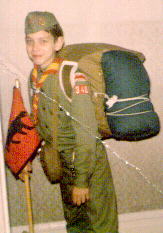 The story of the Dutch contribution to our family spans three-quarters of the globe, colonial orphanages, Nazi occupation and forced labor, and American immigration of an extended family. Of all the Van Hagens and Van der Tangs that came to the USA, only one member of that initial family is a native-born American.
The story of the Dutch contribution to our family spans three-quarters of the globe, colonial orphanages, Nazi occupation and forced labor, and American immigration of an extended family. Of all the Van Hagens and Van der Tangs that came to the USA, only one member of that initial family is a native-born American.
The equatorial-Asia Dutch East Indies colony (Indonesia) included the large island of Borneo, and even in the earliest part of the 20th century, they were having plenty of trouble governing the huge, diverse population. Aside from the natural tendencies to be free of even a beneficial foreign government, massive numbers of Moslem discontents used religious fervor ( and outright, savage terrorism ) to try and dislodge foreigners and "non-believers". So the Netherlands found itself with an expensive military presence required in Indonesia.
Willem Anton Van Hagen was part of that military presence. A Dutch "Marine" (which translates directly to "navy sailor", rather than the sea-borne infantrymen Americans know as "marines"), he was a medical practioner of some sort; most likely a first-aid combat medic. There, in the city of Banjarmasin, he wed a local girl whose father may have been French. They had three children there: two girls, Josephine ("Neuss") and Cornelia ("Corrie"), along with the only boy, Cornelis, the youngest, born in 1921. While Cornelis was still a small boy, the mother died, and the children were handed over to a Salvation Army-operated orphanage. Van Hagen remarried, and the children returned to find themselves in something like a Cinderella situation, but without any fairy godmothers. The father was at sea for long periods of time, and the older girls often ran away - but constantly sought to protect their little brother from their stepmother's clutches. Eventually, Van Hagen retired from the military and the family sought a better life in Holland, the land of their citizenship.
The
1895 photo of Jan Van der Tang
 |
Teuntje, his real mother, 1915 (b.1852)
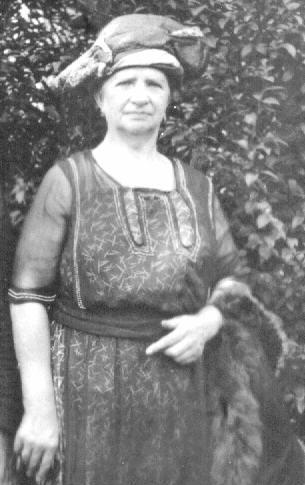 |
Van der Tangs of Holland had far less disruption to their lives at the turn of the century and later years - though they couldn't know the effect a nearby German madman would later have upon them. Born in 1892, the adopted Aart Jakob ("Jan") Van der Tang lived in Amsterdam but soon moved to the town of Drunen. As an adult he met and in 1916, married Catharina Van der Sanden (b. 1891), maintaining a multi-generational family in the town of Wallwyk in the North Brabant region of Holland. There, four girls and one boy were born to them; the youngest girl, Patronella ("Nellie") was born in 1923.
The local industry
Catharina, circa 1950
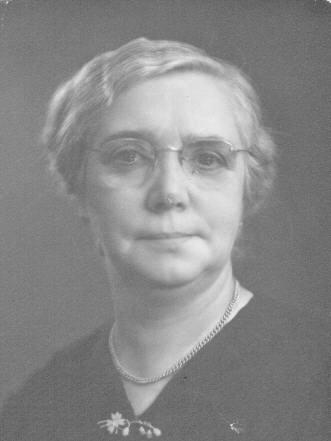 |
was shoemaking and Jan learned the trade well.
Eventually, he obtained work in a shoemaker's shop in Rotterdam, though
Jan, circa 1950
 |
the rest of the family stayed behind, caring for an ailing grandfather. Upon his death, the family was reunited in Rotterdam; Nellie was four years old. About the time of the 1930's worldwide depression, Jan began operating the shop - just as people could no longer afford new shoes made, or even repairs to the old. However, Jan kept up a living via work outsourced from shoe stores.
The Rotterdam neighborhood in 1967
 |
In May 1940, World War II came to Rotterdam; hundreds of dark green planes covered the skies, bombing in waves that Nellie describes as "like pillars towards the river". The heart of the city was virtually leveled by the incindiary bombing and firestorm - but the Van der Tangs in the western outskirts were spared total destruction due to a slim buffer of grass, trees, and a natural water channel which flowed there. However, the destruction of Rotterdam's city center had dire consequences: the nation's resolve to resist collapsed, and the Netherlands surrendered to Nazi occupation within five days.
The Gestapo ruthlessly took over administration of the city, ruling through terror. It was common, when Holland's tiny underground succeeded in killing a German soldier, for the Gestapo to randomly pull ten citizens from their bicycles and shoot them in retribution.
Rotterdam, the largest port in the world, held strategic importance for the Nazis, and commandeered facilities there quickly became the target of daily British bombing raids. The citizens of the city now had mixed emotions about the bombing: they were anxious for the British and other allies to root out the Germans from their land, yet greatly feared the destruction falling from "the Tommies" in the skies above them. They secretly cheered when a Nazi headquarters was hit - but suffered when a neighboring housing block was destroyed.
The citizens of the city now had mixed emotions about the bombing: they were anxious for the British and other allies to root out the Germans from their land, yet greatly feared the destruction falling from "the Tommies" in the skies above them. They secretly cheered when a Nazi headquarters was hit - but suffered when a neighboring housing block was destroyed.
Nellie tells the story of a British bomb falling straight down the shaft of her future sister-in-law's chimney. Spared this time, the bomb lodged partway down the shaft and didn't go off. [ One important weave in the tapestry of time: that woman, one of the Van Hagen children from Indonesia, was the first of the Dutch relatives to immigrate to the US, eventually sponsoring the rest of the emigres. Had she died in that raid, it would have definitely altered the future for my family. ]
As the war wound on, food and clothing became harder to get in Rotterdam;
Rotterdam deli in better times
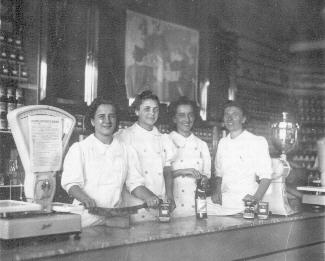 |
everything was rationed, and the black market began to be the only reliable source for some items. Near the end of the war, even bread and potatoes were impossible to get; the output of Holland's rich farmlands were directed to Germany.
Cornelis, 1945
 |
Unemployed teens and young adults had to find work or be transported to Germany for "important" work there. Young Cornelis Van Hagen was caught in this trap. An apprentice machinist, he became a forced-labor captive in a German factory. Living in a crowded dormitory, they worked for their room and board, little more.
Joan and Gerard v.d. Tang, 1946
Served in Indonesia with the RNLAF
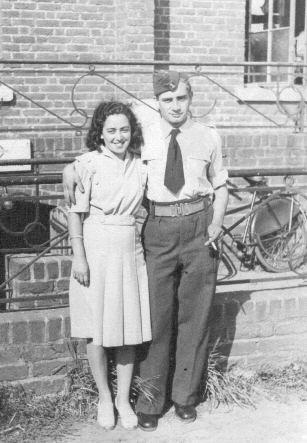 |
He learned a lot about the craft there, though - especially since the defects intentionally introduced into the electric motors and compressors they produced had to break after they were shipped - yet be undetectable beforehand.
In time, the nation was freed by the allies (primarily Canadians),
Nellie Van Hagen, 1954
 |
and it was only a matter of time before Germany itself would be occupied. Shortly after the allies advanced onto German soil, the word got to the forced-labor factories - but Cornelis couldn't wait months more. One day, he simply walked away and boarded a westbound train; his lack of papers could get him shot on sight, but the closer he got to Holland, the more the Germans were preoccupied with retreat, surrender, and the fear of being sent to the Russian front. He arrived safely in Rotterdam, and would marry Nellie Van der Tang soon afterward.
"Rina" and "Jos" circa 1953
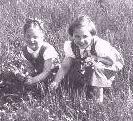 |
Two daughters were born to the Van Hagens, Josephine (1946) and Catherina (1949) in Rotterdam. Their paternal aunt Nuess - whose married name was Van Dyk - had boys: Bert and Casey. Rotterdam was still rebuilding after the war's destruction, so housing was in very short supply [continuing through the 1960s, in fact] - but life was reasonably comfortable in postwar Holland otherwise. That is why the Van Dyk's decision to emigrate to the US seemed unusual. By the early 1950's, they were in the Bronx, and writing home about the high pay, spacious apartments (?), and opportunities available in New York.
 In time, Cornelis and Nellie Van Hagen gave in to the desire to emigrate as well - as much to obtain better housing as any other reason. The girls were in school now, and the apartment they shared was just too small - with no prospects for obtaining a larger one. They sold off their possessions, and spent a short period with Corrie awaiting passage from Rotterdam to the port in Hoboken - just across the Hudson from Manhattan.
In time, Cornelis and Nellie Van Hagen gave in to the desire to emigrate as well - as much to obtain better housing as any other reason. The girls were in school now, and the apartment they shared was just too small - with no prospects for obtaining a larger one. They sold off their possessions, and spent a short period with Corrie awaiting passage from Rotterdam to the port in Hoboken - just across the Hudson from Manhattan.
Fortunately for the threads of time affecting this family, they didn't settle in Hoboken.
Aboard the S.S. Ryndam, 1956
 |
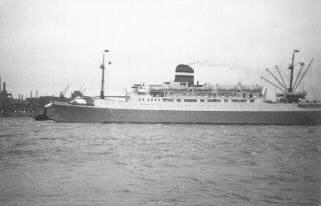 Instead, they moved into the apartment building directly across the street from me, in the Bronx. Like most immigrants, they tended to keep to themselves, and to their own kind - but there weren't very many Hollanders in the South Bronx, and they spoke just a few words of English. Cornelis found work almost immediately - and often.
Instead, they moved into the apartment building directly across the street from me, in the Bronx. Like most immigrants, they tended to keep to themselves, and to their own kind - but there weren't very many Hollanders in the South Bronx, and they spoke just a few words of English. Cornelis found work almost immediately - and often.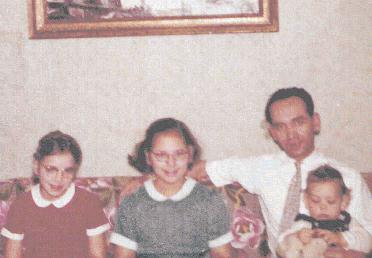 The grand security of the "last hired, first fired" doctrine common in NY wasn't so great when you were fresh off the boat. Before too long, he had settled into a millwright's position assembling the city-block long printing machines of H.R. Hoe & Co., just a quick walk "down the river" from 140th Street.
The grand security of the "last hired, first fired" doctrine common in NY wasn't so great when you were fresh off the boat. Before too long, he had settled into a millwright's position assembling the city-block long printing machines of H.R. Hoe & Co., just a quick walk "down the river" from 140th Street.
In time, he got word of an even better position in Brooklyn from an unrelated Dutch friend - and became a career installation and repair man for a company that assembled equally huge machines for making and printing triple-walled corrugated boxes (from massive rolls of kraft paper). The company sold them all over the world - and he travelled Europe, South America, Asia, and North America installing machines that took up entire factories. He was a "natural" for such things: he spoke technical Dutch, German, and English well - and "made do" when French or Spanish came along. Even after retirement, he was still called in for worldwide jobs - as old-fashioned skills declined; now, however, he would be picking up the premium pay, instead of the company.
machines for making and printing triple-walled corrugated boxes (from massive rolls of kraft paper). The company sold them all over the world - and he travelled Europe, South America, Asia, and North America installing machines that took up entire factories. He was a "natural" for such things: he spoke technical Dutch, German, and English well - and "made do" when French or Spanish came along. Even after retirement, he was still called in for worldwide jobs - as old-fashioned skills declined; now, however, he would be picking up the premium pay, instead of the company.
My grandparents - on both sides - died a decade or more before I was born, so I never got to meet them. Thus, it seems a little strange to me that my own children think so little of growing up with their Dutch grandparents so accessible. To them, it is just a commonplace fact. However, the thing that really bowled me over was seeing FOUR generations at once, the time we drove up to Rotterdam from Germany in 1978.
I have a great 35mm slide containing four generations of "Van der Tang" girls - Catharina, Patronella, Catherine, and Veronica - but slides are notoriously un-scannable without special equipment. I was particularly amazed by the kids' great-grandmother: She was 12 when the Wright Brothers first flew (and when my own father was born) - and 78 when men landed on the moon. She saw the introduction of automobiles to Europe, two "wars to end all war", the earliest commercial radios, witnessed TV transmissions from the surface of Mars - and was bright, alert, and cracking jokes (in Dutch) when she finally met her American great-grandson at 86. (She loved his blue eyes...) A few words about Dutch Society.
I remember those strange Van Hagen girls on 140th Street; I would see them going in and out of the building, speaking to no one, seemingly always in a hurry. They didn't play with the kids in the neighborhood at all - though they did go to the same school. No one really knew anything about them, except that they were Casey's cousins, they always wore glasses, and maybe we should leave them alone - even during water gun "season". Both had become citizens along with their parents, but they were still a mystery. The younger one would sometimes be seen pushing a baby carriage containing her little brother, but she never interacted with us at all. Then one day when I was thirteen, I looked across the street and noticed this tall long-legged blond girl, playing King-Queen against the building wall.
I still remember those tight white shorts - but didn't recognize her as the little Dutch girl who wore glasses and didn't speak. Suddenly, I didn't care - because she was somehow even more interesting than my bike. It turns out, she could speak just fine ! (And didn't need the glasses, either.)
seemingly always in a hurry. They didn't play with the kids in the neighborhood at all - though they did go to the same school. No one really knew anything about them, except that they were Casey's cousins, they always wore glasses, and maybe we should leave them alone - even during water gun "season". Both had become citizens along with their parents, but they were still a mystery. The younger one would sometimes be seen pushing a baby carriage containing her little brother, but she never interacted with us at all. Then one day when I was thirteen, I looked across the street and noticed this tall long-legged blond girl, playing King-Queen against the building wall.
I still remember those tight white shorts - but didn't recognize her as the little Dutch girl who wore glasses and didn't speak. Suddenly, I didn't care - because she was somehow even more interesting than my bike. It turns out, she could speak just fine ! (And didn't need the glasses, either.)
Of course, that's a different story - covered elsewhere on the site.
Photographs and text © 1999 John P. Tomany
Some photos ©1999, Patronella Van Hagen, used w/permission
 The story of the Dutch contribution to our family spans three-quarters of the globe, colonial orphanages, Nazi occupation and forced labor, and American immigration of an extended family. Of all the Van Hagens and Van der Tangs that came to the USA, only one member of that initial family is a native-born American.
The story of the Dutch contribution to our family spans three-quarters of the globe, colonial orphanages, Nazi occupation and forced labor, and American immigration of an extended family. Of all the Van Hagens and Van der Tangs that came to the USA, only one member of that initial family is a native-born American.




 The citizens of the city now had mixed emotions about the bombing: they were anxious for the British and other allies to root out the Germans from their land, yet greatly feared the destruction falling from "the Tommies" in the skies above them. They secretly cheered when a Nazi headquarters was hit - but suffered when a neighboring housing block was destroyed.
The citizens of the city now had mixed emotions about the bombing: they were anxious for the British and other allies to root out the Germans from their land, yet greatly feared the destruction falling from "the Tommies" in the skies above them. They secretly cheered when a Nazi headquarters was hit - but suffered when a neighboring housing block was destroyed.




 In time, Cornelis and Nellie Van Hagen gave in to the desire to emigrate as well - as much to obtain better housing as any other reason. The girls were in school now, and the apartment they shared was just too small - with no prospects for obtaining a larger one. They sold off their possessions, and spent a short period with Corrie awaiting passage from Rotterdam to the port in Hoboken - just across the Hudson from Manhattan.
In time, Cornelis and Nellie Van Hagen gave in to the desire to emigrate as well - as much to obtain better housing as any other reason. The girls were in school now, and the apartment they shared was just too small - with no prospects for obtaining a larger one. They sold off their possessions, and spent a short period with Corrie awaiting passage from Rotterdam to the port in Hoboken - just across the Hudson from Manhattan.
 Instead, they moved into the apartment building directly across the street from me, in the Bronx. Like most immigrants, they tended to keep to themselves, and to their own kind - but there weren't very many Hollanders in the South Bronx, and they spoke just a few words of English. Cornelis found work almost immediately - and often.
Instead, they moved into the apartment building directly across the street from me, in the Bronx. Like most immigrants, they tended to keep to themselves, and to their own kind - but there weren't very many Hollanders in the South Bronx, and they spoke just a few words of English. Cornelis found work almost immediately - and often. The grand security of the "last hired, first fired" doctrine common in NY wasn't so great when you were fresh off the boat. Before too long, he had settled into a millwright's position assembling the city-block long printing machines of H.R. Hoe & Co., just a quick walk "down the river" from 140th Street.
The grand security of the "last hired, first fired" doctrine common in NY wasn't so great when you were fresh off the boat. Before too long, he had settled into a millwright's position assembling the city-block long printing machines of H.R. Hoe & Co., just a quick walk "down the river" from 140th Street. machines for making and printing triple-walled corrugated boxes (from massive rolls of kraft paper). The company sold them all over the world - and he travelled Europe, South America, Asia, and North America installing machines that took up entire factories. He was a "natural" for such things: he spoke technical Dutch, German, and English well - and "made do" when French or Spanish came along. Even after retirement, he was still called in for worldwide jobs - as old-fashioned skills declined; now, however, he would be picking up the premium pay, instead of the company.
machines for making and printing triple-walled corrugated boxes (from massive rolls of kraft paper). The company sold them all over the world - and he travelled Europe, South America, Asia, and North America installing machines that took up entire factories. He was a "natural" for such things: he spoke technical Dutch, German, and English well - and "made do" when French or Spanish came along. Even after retirement, he was still called in for worldwide jobs - as old-fashioned skills declined; now, however, he would be picking up the premium pay, instead of the company.

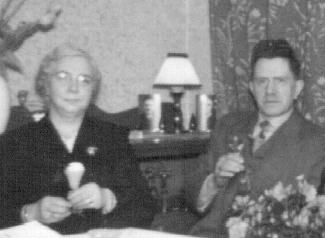
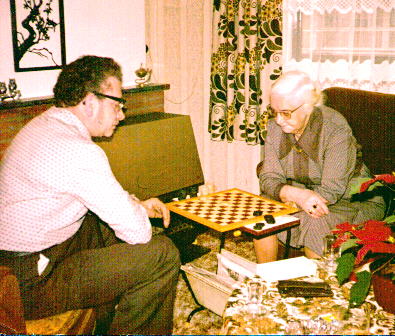
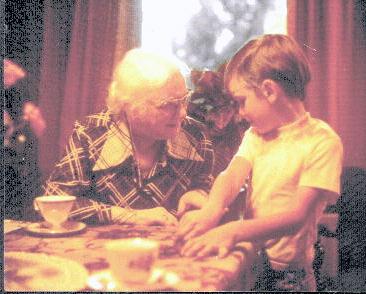
 seemingly always in a hurry. They didn't play with the kids in the neighborhood at all - though they did go to the same school. No one really knew anything about them, except that they were Casey's cousins, they always wore glasses, and maybe we should leave them alone - even during water gun "season". Both had become citizens along with their parents, but they were still a mystery. The younger one would sometimes be seen pushing a baby carriage containing her little brother, but she never interacted with us at all. Then one day when I was thirteen, I looked across the street and noticed this tall long-legged blond girl, playing King-Queen against the building wall.
I still remember those tight white shorts - but didn't recognize her as the little Dutch girl who wore glasses and didn't speak. Suddenly, I didn't care - because she was somehow even more interesting than my bike. It turns out, she could speak just fine ! (And didn't need the glasses, either.)
seemingly always in a hurry. They didn't play with the kids in the neighborhood at all - though they did go to the same school. No one really knew anything about them, except that they were Casey's cousins, they always wore glasses, and maybe we should leave them alone - even during water gun "season". Both had become citizens along with their parents, but they were still a mystery. The younger one would sometimes be seen pushing a baby carriage containing her little brother, but she never interacted with us at all. Then one day when I was thirteen, I looked across the street and noticed this tall long-legged blond girl, playing King-Queen against the building wall.
I still remember those tight white shorts - but didn't recognize her as the little Dutch girl who wore glasses and didn't speak. Suddenly, I didn't care - because she was somehow even more interesting than my bike. It turns out, she could speak just fine ! (And didn't need the glasses, either.)